
Image courtesy of Scryfall.com
Simulation and Probability: A modern approach to triggers in MTG 🧙♂️
In the sprawling tapestry of Magic: The Gathering, probability-based triggers are the quiet engines behind many deck decisions. Once you stop relying on gut instinct and start running simulations, you unlock a data-driven view of when a trigger actually earns its keep. Lys Alana Bowmaster, a green Elf Archer with reach from Commander Legends, happens to be a perfect suitable star for a thought experiment. Her ability — “Whenever you cast an Elf spell, you may have this creature deal 2 damage to target creature with flying” — embodies a classic decision point: should you trigger for impact now, or hold for a more favorable moment later? The simulated answers aren’t dogmatic, but they illuminate hinges in your strategy, especially in multiplayer Commander where flying threats are a constant tempo check. 🔥
Card snapshot: Lys Alana Bowmaster in Commander Legends
- Name: Lys Alana Bowmaster
- Mana Cost: {2}{G}
- Type: Creature — Elf Archer
- Power/Toughness: 2/2
- Keywords: Reach
- Oracle Text: Reach. Whenever you cast an Elf spell, you may have this creature deal 2 damage to target creature with flying.
- Set: Commander Legends (cmr), a draft-invention staple
- Rarity: Common
This is green tempo with a twist: you pay 3 mana to summon a sturdy archer who can punish flying creatures the moment an Elf spell appears, or you can delay and respond to a broader board state. The choice is always yours, echoing the core of probability-based play: information changes as boards evolve, and so do the optimal triggers. 🧙♂️💎
How probability enters the battle: a practical lens
To reason about Lys Alana Bowmaster through a simulation lens, imagine a scenario where your Elf suite and flying threats scale over a game. You can model variables like:
- Number of Elf spells you cast per turn
- Presence and number of flying creatures on opponent boards
- Availability of alternative targets for the Bowmaster’s 2 damage trigger
- Whether you choose to resolve each trigger (the “may” in the ability) and in which order
- Tempo considerations: does triggering now slow your opponent down or accelerate your win condition?
Running thousands of trials with these variables reveals patterns: in decks leaning into Elf synergy, early Elf plays produce a higher chance that there exists a valid flying target for Bowmaster’s hit; as the game progresses and flying threats wax and wane, your optimal choice may shift toward using the trigger on the most threatening creature rather than any available target. The result is a probabilistic map of when Bowmaster adds reliable burn to your plan and when her damage is more of a tempo swing that buys you a turn or two. 🎲
Key takeaways for deck builders and players
- Elf density matters: A higher concentration of Elf spells increases the opportunities for Bowmaster to deliver repeat damage, but it also raises the chance of over-committing to any single line if you don’t have a clear flying threat on the board to target. 🧝♂️
- Flying threats drive value: Simulations show Bowmaster shines when opponents deploy chunky fliers or well-timed Aerial threats. In such moments, a well-timed 2-damage ping can turn the tide on a stalled board.
- Decision points are dynamic: The “you may” clause is where the art and math meet. If you routinely face deathtouch or sacrificial blockers, you might prefer a more conservative trigger. If you’re staring at a soaring opponent and a shrinking life total, go for the burn. ⚔️
- Predictable vs. explosive outcomes: Bowmaster’s value scales with the rest of your elf and green suite. In some games, a handful of triggers yield modest damage; in others, you chain triggers across multiple Elf casts and steadily chew through flying threats.
- Simulation as a planning tool: You don’t need to hold your breath for perfect prediction. A well-constructed model informs mulligans, card draw order, and when to pivot your strategy mid-game. The payoff is smoother decision-making and less regret after a crowded board phase. 🎨
“In the end, the math doesn’t replace play, it informs it. You still read the board, you still feel the moment, but a few dozen randomized trials can tell you where your decisions are most likely to pay off.” — Deckbuilder, everywhere 🧙♂️
Art, flavor, and the enduring charm
Lys Alana Bowmaster isn’t just a card—she’s a window into a particular era of Commander Legends, where guilds of elves and marching perseverance met in a draft-innovation frame. Dan Murayama Scott’s art captures a grounded, practical archer of the forest, poised and ready to react at a moment’s notice. The green glow of her magic and the reach mechanic visually echo the idea that in green, patience and protection matter as much as the strike. This is a card that invites thoughtful play, not just brute force. 🎨
Productive curiosity: where cross-promotion fits
If your next convention or game night involves more than just stacking cards, consider how durable accessories keep the moment focused. The rugged phone case linked below reflects a vibe of practical readiness—perfect for organizers, streamers, and players who travel with a deck box and a laptop. The coupling of a well-built case with a well-built strategy mirrors the MTG mindset: you prepare, you adapt, and you stay ready for the next draw. 🧰
Ready to explore more? Dive into the resources and articles from our network below, then swing back to the Commander table with a cooler head and a sharper plan.
Rugged Phone Case — Impact Resistant Dual Layer TPU/PC Glossy
More from our network
- https://crypto-acolytes.xyz/blog/post/fubo-shareholders-approve-hulu-live-tv-deal/
- https://blog.digital-vault.xyz/blog/post/generative-ai-for-smarter-product-design/
- https://transparent-paper.shop/blog/post/designing-modern-infographic-templates-for-visual-impact/
- https://blog.digital-vault.xyz/blog/post/blue-hot-star-in-scorpius-illuminates-distance-uncertainty/
- https://blog.digital-vault.xyz/blog/post/blue-white-blaze-at-21-kpc-reveals-galactic-scale/